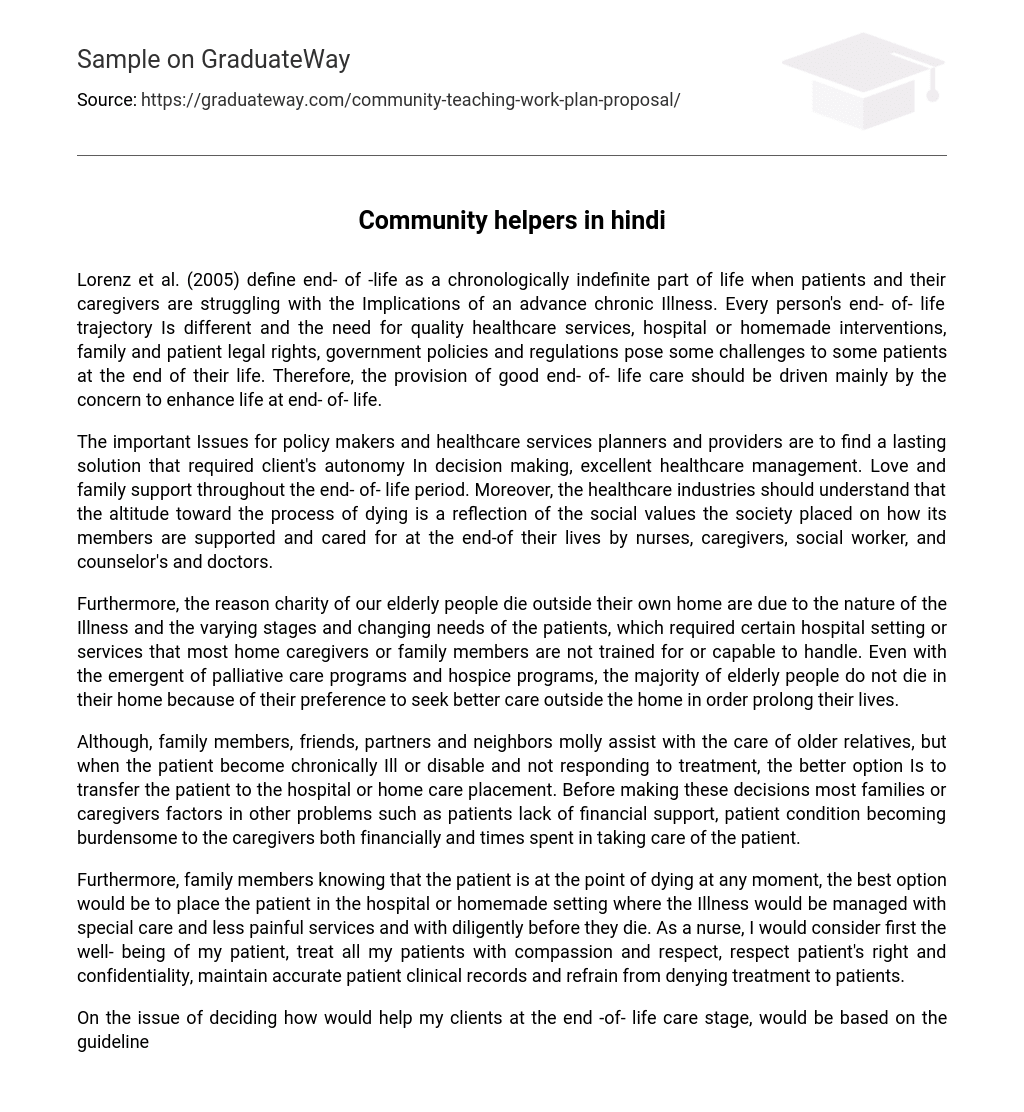Lorenz et al. (2005) define end- of -life as a chronologically indefinite part of life when patients and their caregivers are struggling with the Implications of an advance chronic Illness. Every person’s end- of- life trajectory Is different and the need for quality healthcare services, hospital or homemade interventions, family and patient legal rights, government policies and regulations pose some challenges to some patients at the end of their life. Therefore, the provision of good end- of- life care should be driven mainly by the concern to enhance life at end- of- life.
The important Issues for policy makers and healthcare services planners and providers are to find a lasting solution that required client’s autonomy In decision making, excellent healthcare management. Love and family support throughout the end- of- life period. Moreover, the healthcare industries should understand that the altitude toward the process of dying is a reflection of the social values the society placed on how its members are supported and cared for at the end-of their lives by nurses, caregivers, social worker, and counselor’s and doctors.
Furthermore, the reason charity of our elderly people die outside their own home are due to the nature of the Illness and the varying stages and changing needs of the patients, which required certain hospital setting or services that most home caregivers or family members are not trained for or capable to handle. Even with the emergent of palliative care programs and hospice programs, the majority of elderly people do not die in their home because of their preference to seek better care outside the home in order prolong their lives.
Although, family members, friends, partners and neighbors molly assist with the care of older relatives, but when the patient become chronically Ill or disable and not responding to treatment, the better option Is to transfer the patient to the hospital or home care placement. Before making these decisions most families or caregivers factors in other problems such as patients lack of financial support, patient condition becoming burdensome to the caregivers both financially and times spent in taking care of the patient.
Furthermore, family members knowing that the patient is at the point of dying at any moment, the best option would be to place the patient in the hospital or homemade setting where the Illness would be managed with special care and less painful services and with diligently before they die. As a nurse, I would consider first the well- being of my patient, treat all my patients with compassion and respect, respect patient’s right and confidentiality, maintain accurate patient clinical records and refrain from denying treatment to patients.
On the issue of deciding how would help my clients at the end -of- life care stage, would be based on the guidelines of the official positions awaken by the American Medical Association on end- of- life- actions. Mama’s Code of medical Ethics ( AMA,2012-2013) which provides health care physicians with a guidelines on how to deal with issues regarding end- of- life, likewise the nurses ANA;s Code of Ethics (2001) also have a guideline on what is expected from nurses when confronted with end of life issues.
However, these actions should be based on clients wishes, such as Do- Not- Resuscitate Orders, Futile Care process, Quality of Life, Withholding or withdrawing life – sustaining medical treatment, Optimal Use of retirement plan, health care power of attorney and do not resuscitate at home. Furthermore, we all know that some people are contented to leave decisions regarding their death in the hands of the others.
By doing so, they expose themselves to the unnecessary treatments and restrictions. Family members are often forced to make decisions about life- support and treatment without knowing whether their loved one would have wanted these interventions. I would help the patient and the family plan and make the appropriate ethnically choices in accordance with the Hospice and palliative Nursing Association directives.
Also, knowing the end – of -life often involves risks and ethical dilemmas such as in withdrawal of life- sustaining treatment like dialysis or feeding tube and the large need of doses of avoids, I would address the patients need based on ANA guidelines, which stated in the case of administering avoids on end-of- life patient, nurses must use effective doses of medications prescribed for symptom control and nurses have a moral obligation to advocate on behalf of the patient when prescribed medication is insufficiently managing pain and other distressing symptom.
The Agency for Healthcare Research and Quality (ARQ) 2011 COG series between elderly patients under the palliative care and family evaluation of Hospice care patients who have died, shows the extensive evidence and numerous interventions available for patients in palliative care, such as applying many types of medications and other interventions to treat pain are supported by strong evidence of reductions in pain severity and helps to prolong patients life.
On the other hand, patients who re in Hospice care before death has a lot of complaint from the family members and noted that 18. 2 percent of the family members stated inattention to the needs of their love ones and support from hospital among hospices varies from 12. 6% to 21. 4%, and 9 percent of family members reported that their need for emotional support was not met. References MAMA’S Code of Medical Ethics-American Medical Association. Wry. AMA-assn. Org/go/ satisfactoriness. Code of Nurses Ethics for Nurses-American Nurses Association. Www. Nursing’s. Org/codfishes.





